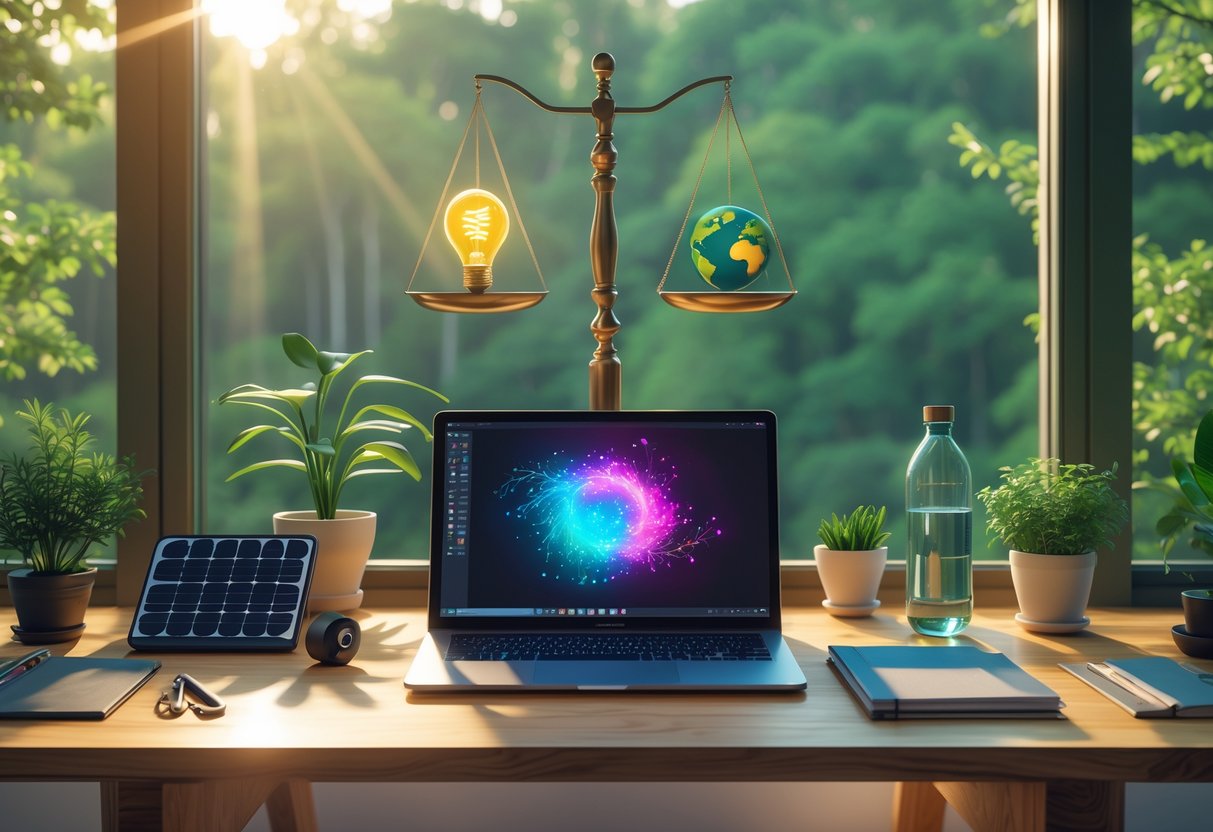Content Creator Transition: How to Go Full-Time & Succeed
Updated On: October 23, 2025 by Aaron Connolly
Understanding the Content Creator Transition
Taking the leap from casual content creation to a sustainable career takes a lot of planning and a good dose of realism. Everyone’s path looks a bit different depending on their niche, but at the end of the day, it usually comes down to building a loyal audience and not relying on just one way to make money.
What Defines a Successful Content Creator Transition
Going full-time isn’t just about quitting your job. You need to bring in enough steady income to support yourself for the long haul.
Financial stability comes first. Most creators who make it recommend saving up at least three to six months of living expenses before making the leap. Ideally, your content income should match or beat your current salary for a few months straight.
Multiple revenue streams keep you safe from sudden changes. Most successful creators pull in money from a mix of:
- Brand sponsorships and partnerships
- Affiliate marketing
- Premium memberships or subs
- Merch and digital products
- Direct support on Patreon or similar platforms
Audience engagement beats follower count every time. Someone with 10,000 really engaged fans can out-earn a creator with 100,000 passive viewers.
Gaming expert James Connolly put it well: “The creators who last are those who treat their audience like a community, not just numbers on a screen.”
Common Pathways to Becoming a Full-Time Creator
Most people don’t just quit their job and go all-in overnight. The process usually unfolds in a few stages.
The gradual build feels safest for most. You keep your regular job while making content on the side. Many creators spend a year or two growing their audience before even thinking about going full-time.
Platform specialisation often comes early on. You might stick to YouTube tutorials, TikTok shorts, or Twitch streams. Each one has its own way of paying creators and different timelines.
Skill development happens right alongside audience growth. You’ll need to learn video editing, SEO, and social media marketing. Plenty of folks take online courses or find mentors to speed things up.
The hybrid phase bridges the gap. Some creators cut back to part-time work or pick up freelance gigs. This takes the pressure off while they grow their creator business.
Strategic timing can make or break the jump. Many creators wait until they land a big sponsorship or hit a high-earning streak before going full-time.
Challenges and Rewards of Making the Leap
The creator economy gives you freedom, but it’s not all sunshine. You have to stay on your toes.
Income instability can stress anyone out. Creator earnings jump around from month to month. Algorithms change, and sometimes your income drops overnight. Smart creators budget carefully and keep an emergency fund just in case.
Constant content pressure wears you down. You’re not just making videos—you’re also handling negotiations, invoices, and all the business stuff.
Competition keeps rising as more people try content creation. If you want to stand out, you’ll have to keep learning and adapting to new trends.
Still, the rewards draw people in. Creative freedom lets you work on what you love. Flexible scheduling means you can travel or manage your days however you want.
Unlimited earning potential is real for a lucky few. The top creators can make way more than they did in their old jobs, though let’s be honest, that’s a small group.
Direct audience connection gives you instant feedback and a sense of community you just don’t get from most traditional jobs.
Self-Assessment and Identifying Your Niche

Before we dive in, we need to figure out what actually makes us stand out and where our skills can shine. The trick is to find that overlap between what we love, what people want, and where the money is.
Evaluating Your Strengths and Passions
Let’s start with what we know best. We’ve all got a gaming background and some natural skills.
Our Gaming Foundation
Write down every game you’ve played seriously. Don’t just stick to competitive titles—throw in casual favorites and even games you’ve only watched a lot. Heck, even mobile games count.
Next, pick out your natural strengths:
• Analytical skills – Do you break down strategies naturally? • Communication – Can you explain tricky stuff simply? • Performance – Are you consistent with high-level plays? • Community building – Do you love helping or connecting with other players?
The Passion Test
Gaming journalist Mia Kwan said it best: “The creators who last are those who genuinely love their niche, not just the idea of being famous.”
Ask yourself:
- Which games could you talk about for hours and not get bored?
- What gaming topics actually get you excited to share?
- When do you feel most energised while gaming or chatting about games?
Be specific. Instead of “I like FPS games,” try “I love breaking down Valorant team comps and explaining why certain agent combos work on certain maps.”
Choosing a Profitable and Fulfilling Niche
Now, we have to be real: not every gaming interest can become a strong content niche.
Market Research Basics
Check out other creators in your potential niche.
- Where are the gaps?
- Are people asking questions that no one’s answering?
- Is the niche too crowded or totally empty?
Quick win: Search YouTube for your niche ideas and sort by upload date. If the latest videos have barely any views, that could mean there’s either too much competition or not enough interest.
The Specificity Sweet Spot
Instead of “gaming content,” go narrow and deep:
| Too Broad | Better | Most Targeted |
|---|---|---|
| Gaming tips | FPS strategies | Valorant agent guides for beginners |
| Esports news | League updates | LEC roster analysis |
| Game reviews | Indie reviews | Cosy indie games under £15 |
The more specific you get, the easier it is to serve your audience and stand out.
Validation Through Competition Analysis
Study 5-10 creators in your chosen niche. Pick ones with 10k-100k followers—they’re big enough to learn from, but not so huge they’re unreachable. Pay attention to what content they make, how often, and how their audience interacts.
Validating Your Niche Through Audience Research
Ideas mean nothing if the audience doesn’t care. You need to test things out before you go all-in.
Start Small, Learn Fast
Make 3-5 pieces of content in your chosen niche. Try:
- Short TikToks or YouTube Shorts
- Detailed Discord posts
- Twitter threads on specific gaming topics
Watch for real engagement—not just empty likes.
Direct Audience Feedback
Join Discord servers and Reddit threads where your target audience hangs out. Don’t jump in promoting yourself. Just listen and share helpful insights.
Heads up: Steer clear of spammy or over-promotional groups. Good communities with active mods usually have more engaged people.
Ask stuff like:
- “What’s the biggest challenge you face with [your niche topic]?”
- “Where do you go for [specific info]?”
- “What kind of content would actually help you get better at [game/skill]?”
The 30-Day Test
Commit to making content in your niche for a month. Track:
- Engagement (comments, shares, saves)
- Audience growth
- How you feel making the content
- Any new opportunities (collabs, brands reaching out)
If you’re dreading it after two weeks, it’s probably not your thing. The right niche should feel tough but still energising—not a chore.
Next: Once you’ve found your niche, you can start building your content strategy and really develop your unique voice.
Building Your Personal Brand
Your personal brand is this mix of your personality, skills, and visual style that people recognise right away. It’s the glue that helps you connect emotionally with your audience and build trust over time.
Developing Your Unique Voice and Story
Your voice is how you talk to your community—everywhere. It’s your tone, your language, and the topics you cover.
Figure out what makes you different. Maybe you’re the streamer who breaks down tough strategies in simple ways. Or maybe people know you for keeping calm under pressure.
Your story matters as much as your skills. Share what got you into gaming or why esports grabbed your attention. These little details give people a reason to care about you, not just your gameplay.
Think about:
- Your gaming journey and big moments
- Challenges you’ve faced
- Your values
- Your current goals
Keep your voice consistent across platforms. If you’re funny and chill on Twitch, don’t suddenly get super formal on YouTube or Twitter. Consistency helps people spot your content instantly.
Try to speak naturally—don’t force a personality. Audiences can always tell when someone’s faking it.
Maintaining Authenticity and Trust
Trust is everything. If your audience doesn’t believe in you, they won’t subscribe, donate, or buy your merch.
Be real about your skills and experience. Don’t fake achievements or pretend you know more than you do. People pick up on that fast.
Share your wins and your fails. Talk about games where you struggled or strategies that backfired. This makes you more relatable.
Research shows that 61% of people prefer following creators they find relatable. So, showing your real personality actually works better than trying to be flawless.
If you mess up or share something wrong, own it and fix it publicly. Audiences respect honesty.
Stick to your values, even if it costs you views. If you don’t like a trending game, don’t force yourself to play it just for numbers.
Designing a Memorable Visual Identity
Your visual identity is everything people see—logos, colors, overlays, graphics. It all adds up to a look that people remember.
Pick 2-3 main colors that fit your vibe. If you’re high-energy, maybe go with bold reds or oranges. If you’re more chill, blues or greys might work better.
Make sure you’ve got matching graphics for:
- Profile pics everywhere
- Stream overlays and alerts
- Thumbnail templates
- Social headers
| Visual Element | Purpose | Cost Range |
|---|---|---|
| Logo design | Brand recognition | £0-£500 |
| Stream overlay | Professional appearance | £20-£200 |
| Thumbnail template | Video consistency | £10-£100 |
Let your visuals match your personality. If you’re loud and energetic, don’t go for minimalist graphics. Everything should feel like “you.”
Keep things simple enough to look good even as a tiny profile pic on a phone.
If you’ve got the budget, hiring a designer can be worth it. Good graphics help you keep viewers and attract sponsors.
Selecting the Right Social Media Platforms
Different platforms work best for different goals when you’re building an esports content career. YouTube is great for deep-dive analysis and tutorials. Instagram and TikTok are perfect for quick highlights and community building. Blogs or podcasts let you explore industry topics in detail.
YouTube for Long-Form and Educational Content
YouTube is still the top pick for esports creators who want to make lasting content. The platform rewards creators who break down gameplay, analyze tournaments, and teach specific game skills.
Content that works on YouTube:
- Match reviews and pro gameplay analysis
- Character guides and strategy tutorials
- Tournament highlights with commentary
- Live practice streams
Once you hit 1,000 subscribers and 4,000 watch hours, you can start earning ad revenue. YouTube’s algorithm likes creators who upload on a regular schedule, so try for 2-3 videos a week instead of random uploads.
The comment section gives you a way to really connect with viewers. A lot of top esports YouTubers started with just one game before branching out.
Quick tip: Use YouTube Shorts to grab TikTok-style viewers and send them to your longer videos.
Instagram and TikTok for Visual and Viral Growth
Instagram and TikTok really shine when it comes to connecting with younger esports fans. People love sharing highlight reels, behind-the-scenes moments, and collaborating with other creators on these platforms.
Platform strengths:
- Instagram: Stories, Reels, and IGTV give you lots of ways to share content
- TikTok: Great for going viral and hopping on trends
- Both: Awesome community features and tools for teaming up
Short-form content is king here. We should stick to 15-60 second clips—think jaw-dropping plays, funny outtakes, or quick tips. TikTok’s For You page can suddenly put our clips in front of thousands of new faces.
Instagram helps us build a personal brand. We can show off our training routines, team hangouts, or tournament travels in Stories. If we’re selling merch, Instagram’s shopping features make it easy.
Heads up: These platforms love to switch up their algorithms, so let’s not put all our eggs in one basket.
Blogs and Podcasts for In-Depth Storytelling
Blogs and podcasts let us dig into esports topics that just don’t fit in a quick video. We can cover industry analysis, interview players, or break down tournaments in detail.
Blog content ideas:
- Tournament predictions and recaps
- Takes on industry news
- Player career spotlights
- Insights into the esports business
Podcasts are perfect for interviews with players, coaches, or other insiders. Lots of fans listen while they’re commuting or taking a break from gaming.
We can stand out by covering stories mainstream media skips. LinkedIn is solid for sharing business-focused blog posts, and Twitter keeps us in the loop during live tournaments.
Quick win: Try guesting on established podcasts before starting our own.
Crafting Engaging Content Formats
Each content format needs its own approach to really grab people. With video, strong visual storytelling matters most. For social media, punchy messages that fit the platform’s vibe work better.
Short-Form vs. Long-Form Content
Short-form content is best for sharing quick tips, highlights, or whatever’s trending. Social media users scroll fast, so posts under 300 words usually get more attention.
Short-form strengths:
- Higher engagement
- Easy to watch or read on your phone
- Loves social media algorithms
- Quick to make
Long-form content, on the other hand, helps us show authority and offer real value. Articles over 1,500 words tend to rank higher in search results and let us dive deep.
Long-form benefits:
- Boosts SEO
- Shows off expertise
- Lets us explain things clearly
- Stays relevant for a long time
We like to hook people with short-form content, then send them to our deep-dive pieces. That way, we get both reach and depth.
Video Production Essentials
Video content gets shared 12 times more than just text or images. You don’t need fancy gear to start.
Key video elements:
- Clear audio (seriously, it matters more than perfect visuals)
- Decent lighting (natural light does wonders)
- Stable shots (tripods or just propping up your phone)
- Thumbnails that pop
Keep social videos under 2 minutes. For YouTube, longer videos can work if the story keeps people watching.
Quick tips:
- Jot down a quick script before filming
- Record in landscape mode
- Add captions so more people can enjoy
- Edit with free tools like DaVinci Resolve
Photography can make your videos a lot better. Use high-quality images for B-roll or thumbnails and you’ll see more clicks.
Effective Social Media Posts
Every platform has its own quirks. What crushes it on LinkedIn might flop on TikTok.
| Platform | Ideal Length | Best Content Type | Posting Frequency |
|---|---|---|---|
| Twitter/X | 71-100 characters | News, quick tips | 3-5 daily |
| 150-300 words | Pro insights | 1-2 daily | |
| 125-150 words | Visual stories | 1 daily | |
| 40-80 characters | Community stuff | 3-5 weekly |
Social media essentials:
- Use platform-specific hashtags
- Post when your crowd is online
- Reply to comments quickly
- Always have a clear call-to-action
Visuals beat plain text by a mile—people share them 40 times more. Pair great photos with captions that actually say something.
Essential Tools and Resources for Content Creation

You don’t need fancy gear to start creating content. Loads of pros kicked things off with free tools and basic setups before upgrading.
Video Editing and Graphic Design Tools
DaVinci Resolve is probably the best free video editor out there. It handles 4K footage, and the colour correction tools rival paid options.
The interface can feel overwhelming at first, but most people pick up the basics after a week of messing around.
Canva makes graphic design a breeze, especially for thumbnails and social posts. Tons of esports templates are ready to go.
You can make thumbnails that look pro in under 10 minutes. The free version covers what most beginners need.
If you want more control, GIMP gives you Photoshop-level tools with zero subscription fees. It takes more time to learn, but you get total creative freedom.
Affordable Equipment for Beginners
Start with what you already have. Most smartphones shoot solid 1080p video.
A USB microphone in the £50-80 range will seriously boost your audio quality. The Audio-Technica ATR2100x-USB is a solid pick for streaming or recording.
Lighting is more important than your camera. A £20 LED panel or ring light can totally change the look of your footage.
Most creators recommend upgrading in this order:
- Get a microphone first
- Add better lighting next
- Upgrade your camera last
Your gaming PC probably streams just fine as-is. OBS Studio lets you stream to Twitch or YouTube for free.
Utilising Templates and Software
OBS Studio is the go-to for live streaming. It works with every major platform and costs nothing.
Grab pre-made stream overlays from StreamElements or similar sites—they’ll save you a ton of time. Many are free and easy to tweak.
Streamlabs gives you built-in alerts, chatbots, and donation tracking. The basic version is free and covers most needs.
Using template libraries speeds things up a lot. Just swap out colours and logos to match your brand.
There are free alternatives for almost every paid tool. Try those first before spending money.
Establishing and Growing Your Online Presence

A strong online presence starts with a professional website that shows off your best work, plus social media profiles that look consistent everywhere. These two pieces help people find you and trust what you do.
Building a Compelling Portfolio or Website
Your website acts as your home base—a place where all your content lives together. Build a clean, easy-to-navigate site that highlights your best stuff from every platform.
Add an About page so people know who you are and what you do. Put your top videos, streams, or articles in a portfolio section. Make it easy for people to contact you and follow you on social media.
Pick a domain name that matches your brand. Most creators just use their real name or their main username.
Quick tip: WordPress, Squarespace, and Wix all make it simple to build a site with no coding. They have templates made for creators.
Keep things fresh—update your site every month or so. Add new samples and ditch anything that doesn’t show your current skills.
Optimising Profiles Across Platforms
Consistent branding makes you stand out. Use the same profile photo, username, and vibe everywhere you can.
Write a bio that says what you make and when you post. Toss in keywords so people can find you. For example: “Gaming content creator | Daily Twitch streams at 7pm GMT | Esports tutorials.”
Profile checklist:
- Same profile pic everywhere
- Consistent username or handle
- Clear, keyword-rich bio
- Link to your website or main channel
- Professional banner image
Update your profiles if you change platforms or add new content types. This boosts your searchability and helps people find you.
Take advantage of features like Instagram highlights, Twitter pinned tweets, or YouTube channel trailers to show off your best work right away.
Monetisation Strategies for Content Creators

Creators today can make money in all sorts of ways—from brand partnerships to selling digital products. The trick is to mix it up: sponsored content, affiliate commissions, and your own products all add up.
Brand Partnerships and Sponsored Content
Brand partnerships are still one of the best ways to earn as a creator. Companies pay you to promote their stuff to your audience.
Sponsored content usually pays anywhere from £100 to £5,000 per post, depending on your followers and engagement. Gaming creators often get higher rates because brands want to reach that 18-34 crowd.
Put together a media kit that includes:
- Your audience stats
- Engagement numbers
- Past brand collabs
- Your pricing
Heads up: Always mark sponsored posts with #ad or #sponsored to stay on the right side of ASA rules.
Sites like AspireIQ or Creator.co help you find brands, but reaching out yourself usually gets you better deals.
Aim for ongoing partnerships, not just one-offs. Long-term deals usually pay 20-30% more.
Affiliate Marketing and Commissions
Affiliate marketing pays you a cut when someone buys a product you recommend. Gaming creators especially benefit from affiliate links for gear, software, or streaming tools.
Popular affiliate programs include:
- Amazon Associates (1-10% commission)
- Gaming gear brands (5-15%)
- Software platforms (20-50% recurring)
Affiliate rates vary a lot. Physical products pay 3-8%, while digital products can go up to 30-50%.
Focus on honest reviews and helpful tutorials, not pushy sales pitches. Your audience will trust you more.
Use tracking links to see what sells. Double down on the best-performing products and formats.
Quick tip: Be transparent—say “I earn a commission if you buy through my links.”
Creating and Selling Digital Products
Digital products are super profitable since you make them once and sell them over and over. Think online courses, eBooks, templates, or exclusive content.
Online courses work great for gaming creators. Topics like “How to Improve Your Aim” or “Streaming Setup Guide” can sell for £50-£200.
Patreon lets you earn steady monthly income. Offer perks like exclusive content, early access, or community hangouts.
Some digital product ideas:
- Game guides and tutorials
- Custom overlays and graphics
- 1-on-1 coaching sessions
- Merch like branded t-shirts
Start small with simple PDFs or guides. Test what people want with free stuff, then make paid versions based on feedback.
You can use Gumroad for downloads, Teachable for courses, or Patreon for subscriptions.
Networking, Collaboration, and Community Building

Building connections with fellow creators cracks open doors for mentorship, collaborative projects, and fresh audience growth. When you form strong relationships in the content creation world, you get both practical support and creative sparks for your next move.
Connecting with Other Creators
Finding your community begins with figuring out where your target audience and peers actually hang out online.
Discord servers, Reddit communities, and platform-specific groups drop you right in the middle of creators in your niche.
Jump into established creator communities:
- Platform-specific groups (Twitch Creator Camp, YouTube Creator Insider)
- Genre-focused Discord servers
- Social media groups for content creators
- Local meetups and workshops
Don’t rush in and pitch collaborations off the bat. Instead, comment thoughtfully on others’ posts, share helpful resources, and join discussions. It’s way more effective than just networking for the sake of it.
Reach out to creators who are at a similar place in their journey. They’re usually dealing with the same stuff and can offer advice that actually fits your situation.
Workshop events—virtual or in-person—give you a natural way to meet others. You’ll find people looking to level up their skills and grow their networks.
Mentorship and Peer Support
Mentorship develops when you consistently engage with experienced creators. Look for folks who openly share knowledge and have a path you’d like to follow.
If you want to approach a potential mentor, offer value first. Maybe you share industry news, give feedback, or help with a project before you ask for advice. Most creators respect genuine interest and a willingness to learn.
Peer support networks can be just as useful for everyday hurdles. Connect with creators who recently started their transition—they’re up to speed on platform changes and what audiences expect right now.
Set up structured support systems:
- Monthly check-ins with creator friends
- Skill-sharing sessions
- Content feedback exchanges
- Goal accountability partnerships
Small mastermind groups work wonders for many creators. These tight-knit circles meet regularly to talk through challenges, celebrate wins, and brainstorm together.
Audience Engagement Techniques
Collaboration and cross-promotion help you reach new audiences. Guest spots on podcasts, joint live streams, and co-created content introduce you to communities you might not access otherwise.
Start with something low-pressure like a social media takeover or guest post. It’s a good way to test if you click with a collaborator without a huge time commitment.
Try these collaboration formats:
- Joint live streams or videos
- Podcast guest slots
- Social media challenges
- Content series partnerships
- Hosting community events
Jump into other creators’ comment sections and live chats. When you contribute thoughtfully, people start noticing you—and that can lead to organic growth.
Building a community means showing up consistently. Reply to comments, join trending discussions, and share others’ content with your own take. It signals you’re not just there for self-promotion.
Host events like Q&As, tutorials, or group streams. These show you’re invested in giving back and let you highlight your skills to new folks.
Adapting to Industry Trends and Algorithm Changes

Content creators need to stay on top of platform updates and try out new formats while tracking their stats. If you keep an eye on industry trends, you’re less likely to get blindsided by algorithm shifts.
Staying Informed on Platform Updates
Platform algorithms change all the time, and that affects how your stuff gets seen. We suggest joining online communities and forums where creators share updates as they happen.
Good info sources:
- Official platform newsletters and updates
- Creator Discord servers
- Industry sites like Social Media Today
- YouTube Creator Insider for YouTube news
Set up Google Alerts for your main platforms plus “algorithm update” so you catch changes early. Many creators spend about 30 minutes a week reading up on updates.
Follow creators in your niche who talk about algorithm changes. They often break down what’s working in real life.
Quick tip: Subscribe to a few creator-focused newsletters so updates land in your inbox.
Experimenting with New Content Types
Trying out different formats helps you keep up when platforms push new features. Usually, platforms boost new content types to get people to use them.
Start with one experiment a week. No need to flip your whole strategy overnight.
Experiment ideas:
- Short-form videos (YouTube Shorts, TikTok, Reels)
- Live streams
- Community polls or interactive posts
- Collaborations with other creators
Track which experiments click with your audience. Some formats are better for drawing in new folks, while others keep your core followers engaged.
Heads up: Don’t drop what’s already working. Mix new stuff with the content your audience already loves.
Write down what works and what flops. You’ll build your own playbook over time.
Tracking Performance and Analytics
Regularly check your performance metrics to see how algorithm tweaks affect your reach. We need data to make smart decisions about what to try next.
Key metrics to watch:
- Reach and impressions
- Engagement rates
- Click-through rates
- Audience retention (for videos)
Use the analytics tools built into your platforms first. Third-party tools can help, but native data is usually more accurate.
Make a monthly report comparing how different content types perform. Look for trends when algorithms change.
Set up automated reports if you can. Most platforms will email you performance summaries.
Quick win: Export your analytics every month so you have a record to spot trends.
Balancing Creativity with Sustainability

Most creators start with tons of energy and ideas. The real test? Keeping that spark alive while building something that lasts for years.
Time Management for Full-Time Creators
Time is your most precious asset when content creation becomes your job. Honestly, we’ve watched too many creators burn out by treating every hour the same.
Energy-based scheduling beats time-based planning. Track your creative energy for a couple of weeks. Most folks get 3-4 hours of peak creativity daily.
Use those peak hours for your hardest creative work. Save admin stuff—emails, thumbnail edits—for your low-energy times.
Here’s a sample daily schedule:
| Time | Energy Level | Task Type |
|---|---|---|
| 9-11am | Peak | Writing/filming new content |
| 11am-12pm | Medium | Editing previous content |
| 2-4pm | Peak | Creative planning/brainstorming |
| 4-5pm | Low | Social media responses |
| Evening | Recovery | No content work |
Batch similar tasks. Record several videos in one go instead of spreading them out. It saves time and keeps you in the zone.
Draw clear lines between work and downtime. Working from home makes it way too easy to check “just one more comment” late at night.
Avoiding Burnout
Burnout sneaks up when content creation becomes a chore. We’ve seen creators ignore the signs until they’re forced to take long breaks.
Watch for early burnout signs:
- Dreading content sessions
- Forcing ideas just to hit your schedule
- Feeling out of touch with your own work
- Not connecting with your community
You don’t always need to work less—just work differently. Some creators post less often but keep quality and joy high.
Try a 70/30 split. Seventy percent planned content for consistency, thirty percent spontaneous for excitement.
Block off time each week for “creative exploration.” No pressure to publish—just mess around with new ideas.
Rate your satisfaction after each session. If you’re below a 6 out of 10 often, it’s a sign you need to switch things up before burnout sets in.
Take real breaks. Give yourself at least one day off every week. Use it to watch other creators or just do something unrelated.
Maintaining a Long-Term Career
Think of content creation as a conversation, not a performance. Creators who treat their work like an ongoing chat with their audience usually stick around longer.
Mix up your formats to keep things fresh. If you write a lot, try a video now and then. New formats can recharge your creativity.
Build systems to protect your energy:
- Templates for regular content
- Clear rules for which ideas to pursue
- Automated workflows for publishing and promotion
- Standard replies for common questions
Focus on your community, not just the numbers. Creators who build real relationships with their audience often last longer than those chasing viral hits.
Pick up skills beyond just content creation. Learn some business basics, get comfortable with analytics, or dive deeper into your niche.
Stay ready for platform or algorithm shifts. The creators who last don’t depend on a single platform or income source.
Track sustainability alongside standard metrics:
- Number of ideas generated monthly
- Energy levels before and after creating
- Quality of audience interactions
- Personal satisfaction with your work
These things predict long-term success way better than just counting views or followers.
Scaling Your Content Creation Business

Building a sustainable content business means finding different ways to make money and launching your own products that keep earning even when you’re offline. The top creators blend brand deals with their own merch and digital products to keep income steady.
Diversifying Revenue Streams
Smart creators never rely on just one income stream. Brand deals can dry up, and platforms change their monetization rules all the time.
The trick is to build multiple income sources that fit together. Maybe you start with sponsored posts from gaming brands, then add affiliate links for gear you actually use.
Direct monetization options:
- Monthly subscriptions (Patreon, etc.)
- Paid coaching for aspiring players
- Exclusive content for premium fans
- Community membership fees
Brand partnerships work best when they make sense for your content. Gaming headsets, energy drinks, and streaming tools are natural fits for esports creators.
Types of partnerships:
- One-off sponsored posts
- Ambassador deals
- Product seeding
- Event sponsorships
Track which partnerships your audience likes most. Try to keep sponsored content under 20% of what you share to stay authentic.
Launching Your Own Brand and Products
When you create your own products, you control the price and the profits. Start out with digital products—they need almost no upfront investment.
Digital products can scale up easily once you make them. You could sell gaming guides, tutorials, or coaching programs, especially if you have skills in a specific game.
Popular digital products:
- Training courses for players
- Team strategy guides
- Commentary or analysis breakdowns
- Custom content templates
Merch takes more effort but builds deeper loyalty. Start with simple stuff like hoodies or gaming gear.
Merchandise tips:
- Print-on-demand keeps costs low
- Gaming-themed designs beat generic logos
- Quality matters more than quantity
- Ask your community what they want
Test digital products first. Move to physical merch once you know what your audience will buy. This way, you lower your risk and build steady income.
Frequently Asked Questions

When you shift your content creation approach, you’ll probably worry about audience retention, engagement, and how you’ll communicate the changes. These questions tackle the real challenges you’ll hit as you change your creative direction.
How can I effectively change my niche as a content creator without losing my audience?
Start by looking closely at your current audience. Check out analytics tools to see who actually engages with your content.
Try to spot any connections between your old and new topics. Sometimes, there’s more overlap than you’d expect.
Mix things up by making bridge content that blends both niches. This way, you can help your followers understand the change and maybe even bring in some new faces.
Say you’re moving from gaming to esports analysis—why not create something about competitive gaming strategies? That sort of crossover can ease people into the shift.
Ask your audience directly what they want to see next. Polls or open questions in the comments often get honest feedback.
People usually like when creators are upfront about changes. If you’re transparent, most followers will stick around and support you.
Keep a few familiar elements from your original niche as you introduce new content. Loyal followers appreciate a bit of consistency while you build up your new focus.
What strategies should I use to introduce new types of content to my followers?
Don’t overhaul everything at once. Start with small experiments—try shorter videos, story posts, or quick community updates.
Watch how people react before you go all-in. Engagement and feedback will tell you a lot.
Stick with your usual content style when you tackle new topics. If people know you for your humor, bring that same energy to whatever you try next.
Drop a few teasers about upcoming changes. Behind-the-scenes posts or announcement videos can spark curiosity and get people ready for what’s next.
Post new stuff during your best-performing times. Use your established schedule to give new content a fair shot at reaching your core audience.
What are some tips for maintaining engagement during a transition period in content creation?
Spend more time replying to comments and DMs when you’re in transition. Building those connections can really help keep your community together.
Try out community-focused pieces like Q&As or live streams. These formats let your personality shine, even if your topics are shifting.
Stick to your usual posting schedule, even if the content itself changes. Consistency matters when viewers aren’t sure what to expect.
Let your audience in on your creative process. Show them your transition journey, both the struggles and the wins.
Can you suggest ways to communicate changes in content direction to my audience?
Make a dedicated announcement post or video to explain what’s going on. Be honest about your reasons and what people can expect.
Don’t rely on just one platform to get your message out. Share updates across all your channels, and tweak your message for each one.
Talk openly about any concerns you think your followers might have. If you know some people might not be thrilled, acknowledge it and thank them for sticking with you.
Let your audience know what’s staying the same. Reassure them about your schedule, your personality, or any content formats they already love.
What are the best practices for measuring the success of new content after a transition?
Focus on engagement rates at first, not just views. Sometimes new content gets fewer views but more meaningful interaction.
Keep an eye on comments, shares, and how long people actually watch your videos.
Compare how different types of new content perform. This helps you figure out what really clicks with your audience.
Don’t expect instant results. New niches can take a few months to gain traction, so track your progress weekly and look for real trends.
Check your audience retention numbers to see where viewers drop off. That info can help you tweak your structure, pacing, or topics as you settle into your new direction.
How long should I expect a content transition period to last before my audience adjusts?
Usually, content transitions take about 2-4 months before your audience really adapts. That window gives you enough time to try out several content cycles, and it lets algorithms catch up to your new topics and audience.
You’ll probably see a dip in your audience during the first month. Honestly, that’s just part of the process—some folks who liked your old stuff might bail. Try not to stress about those short-term numbers; just keep your energy on making good content.
Instead of hoping for instant results, aim for steady progress. Most of the time, people start showing they’re on board after about 6-8 weeks if you keep putting out consistent new content.
You can call your transition done when your new stuff does as well as your previous top-performing content. Depending on how big your shift is and how you handle it, this could take anywhere from 4 to 6 months.








